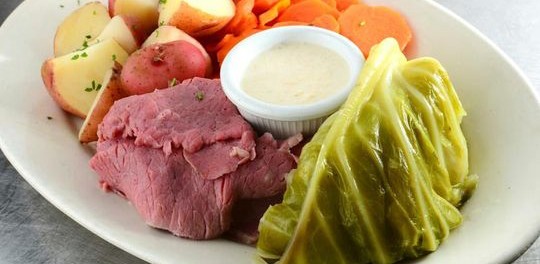Corned Beef is core of a Traditional New Year’s Eve Meal
Corned Beef and Cabbage is more than just a St. Patrick's Day treat
The famous corned beef and cabbage meal is not just for St. Patrick’s Day anymore; according to the USDA, it’s actually a thoroughly American dish that’s been served around New Year’s since the 1800’s.
Corned beef has been around for centuries and has been a staple in many cultures, including most of Europe and the Middle East. It gets its name from the “corns” or large grains of salt used to cure the meat. Ireland became known for exporting corned beef in the 17th century after British land owners brought cattle into Ireland. But the Irish people couldn’t afford to eat it themselves. Their traditional dishes used corned pork instead, and they relied heavily on nutrient-dense potatoes to survive.
In the 18th century, when large numbers of Irish immigrants came to the U.S., they brought with them the idea of beef as a luxury. So when they found salted beef brisket was cheap in the States, they were quick to replace their traditional “Irish bacon.” Nutrient-dense cabbage was also readily available and affordable, and a dish combining the two became a staple for working classes across the country.
According to an article that appeared in the Indy Star, corned beef and cabbage is served for luck on New Year’s Eve:
Corned beef and cabbage on New Year’s is associated with the fortune you should hope for in the coming year. Beef or pork is the meat of choice because unlike chickens these animals do not scratch in the dirt for their food. It’s said that if you eat chicken on New Year’s Day you are setting your destiny for the coming year to scratch in the dirt for your survival, which sounds pretty awful if you ask us. Cabbage is light green, like paper money. And who couldn’t use more of that? Pick yours up (the corned beef not the money) at Kincaid’s Meat Market.
Pressure Cooker Corned Beef
1 corned beef brisket, 3 to 5 pounds
1/2 tsp. celery seed
6 carrots, peeled and with tops removed
1 large onion, peeled and diced
4 c. water or low-sodium chicken broth
Rinse excess salt and brine from the surface of the brisket. Place into pressure cooker. Add carrots, sliced thickly into segments, and diced onion. Add water or broth, spices from packet and celery seed. Cover and set pressure to 15 lbs (or high).
When the correct pressure is reached, reduce heat and set timer, estimating 20 minutes per pound. Remove from heat when cooking time has passed and allow pressure to reduce slowly before opening cooker, about 15 minutes. Remove meat to cutting board; cut with the grain. Makes 12 to 20 4 oz.servings

